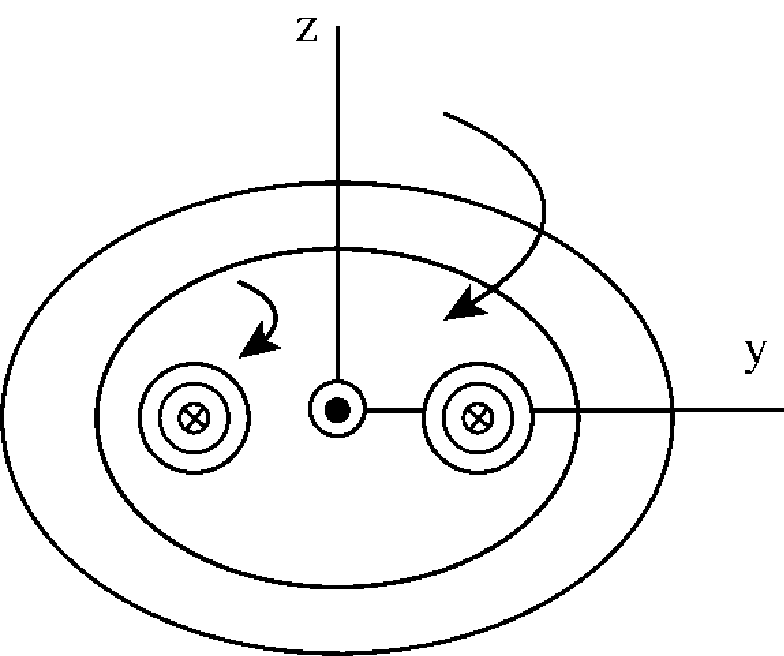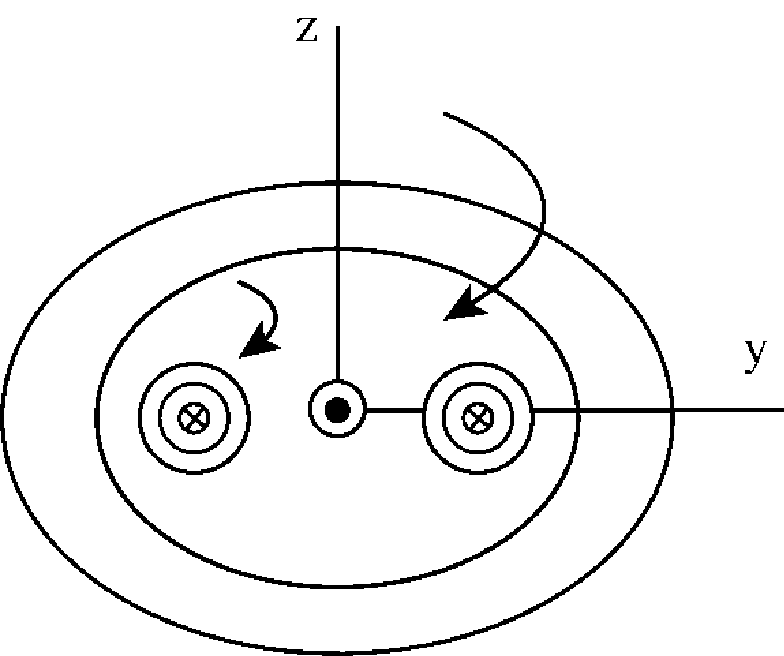
Concept explainers
(a)
The sketch of the magnetic field pattern in the
(a)
Answer to Problem 72CP
The sketch of the magnetic field pattern in the

Explanation of Solution
The sketch of the magnetic field pattern in the

Figure-(1)
The current in the infinitely long wires are in the negative
(b)
The value of the magnetic field at the origin.
(b)
Answer to Problem 72CP
The value of the magnetic field at the origin is zero.
Explanation of Solution
There is symmetry in the loop, so the contribution of each wire to the magnetic field at the origin will be same in magnitude but opposite in the direction. So the net magnetic field at the origin will be zero.
Therefore, the value of the magnetic field at the origin is zero.
(c)
The value of the magnetic field at
(c)
Answer to Problem 72CP
The value of the magnetic field at
Explanation of Solution
Write the expression for the magnetic field.
Here,
Conclusion:
Substitute
Therefore, the value of the magnetic field at
(d)
The magnetic field at points along the
(d)
Answer to Problem 72CP
The magnetic field at points along the
Explanation of Solution
Write the equation of the magnetic field in
So, this can be written as,
Conclusion:
Substitute
Therefore, the magnetic field at points along the
(e)
The distance along the positive
(e)
Answer to Problem 72CP
The distance along the positive
Explanation of Solution
Write the condition the maximum magnetic field.
Substitute
Conclusion:
Substitute
Therefore, the distance along the positive
(f)
The maximum value of the magnetic field.
(f)
Answer to Problem 72CP
The maximum value of the magnetic field is
Explanation of Solution
Conclusion:
Substitute
Therefore, the maximum value of the magnetic field is
Want to see more full solutions like this?
Chapter 30 Solutions
Bundle: Physics for Scientists and Engineers with Modern Physics, Loose-leaf Version, 9th + WebAssign Printed Access Card, Multi-Term
- I need correct answer not chatgptarrow_forwardWhat is the resistance (in (2) of a 27.5 m long piece of 17 gauge copper wire having a 1.150 mm diameter? 0.445 ΧΩarrow_forwardFind the ratio of the diameter of silver to iron wire, if they have the same resistance per unit length (as they might in household wiring). d. Ag dFe = 2.47 ×arrow_forward
- Find the ratio of the diameter of silver to iron wire, if they have the same resistance per unit length (as they might in household wiring). d Ag = 2.51 dFe ×arrow_forwardShow that the units 1 v2/Q = 1 W, as implied by the equation P = V²/R. Starting with the equation P = V²/R, we can get an expression for a watt in terms of voltage and resistance. The units for voltage, V, are equivalent to [? v2 v2 A, are equivalent to J/C ✓ X . Therefore, 1 = 1 = 1 A V1 J/s Ω V-A X = 1 W. . The units for resistance, Q, are equivalent to ? The units for current,arrow_forwardPlease solve and answer the question correctly please. Thank you!!arrow_forward
 Physics for Scientists and Engineers: Foundations...PhysicsISBN:9781133939146Author:Katz, Debora M.Publisher:Cengage Learning
Physics for Scientists and Engineers: Foundations...PhysicsISBN:9781133939146Author:Katz, Debora M.Publisher:Cengage Learning Principles of Physics: A Calculus-Based TextPhysicsISBN:9781133104261Author:Raymond A. Serway, John W. JewettPublisher:Cengage Learning
Principles of Physics: A Calculus-Based TextPhysicsISBN:9781133104261Author:Raymond A. Serway, John W. JewettPublisher:Cengage Learning Physics for Scientists and Engineers with Modern ...PhysicsISBN:9781337553292Author:Raymond A. Serway, John W. JewettPublisher:Cengage Learning
Physics for Scientists and Engineers with Modern ...PhysicsISBN:9781337553292Author:Raymond A. Serway, John W. JewettPublisher:Cengage Learning Physics for Scientists and EngineersPhysicsISBN:9781337553278Author:Raymond A. Serway, John W. JewettPublisher:Cengage Learning
Physics for Scientists and EngineersPhysicsISBN:9781337553278Author:Raymond A. Serway, John W. JewettPublisher:Cengage Learning
 Physics for Scientists and Engineers, Technology ...PhysicsISBN:9781305116399Author:Raymond A. Serway, John W. JewettPublisher:Cengage Learning
Physics for Scientists and Engineers, Technology ...PhysicsISBN:9781305116399Author:Raymond A. Serway, John W. JewettPublisher:Cengage Learning





